Tomás Saraceno
Realistic Idealism
When asked where he is from, Saraceno simply replies, “I am from planet earth.” At the tender age of one, Tomás Saraceno and his parents were exiled to Italy, only returning to Argentina 11 years later, in 1986. This transition, and the social and political insight it provided, is perhaps the driving force behind Saraceno’s acute motivation for people to inhabit the globe without social or nationalistic boundaries.

Contained within their own planetary domain, in this case the walls of an exhibition space, his large-scale sculptural installations are distinct and self-governing environments made of spheres and strands that together form an intricate network created according to an exact theory, and produced by its correlating mathematical equation. His work combines the fields of science, architecture and art, allowing him to be analytical and precise as well as poetic and otherworldly. Although his installations are infused with an exactitude that reassures his audience of the fact that there is a larger theoretical order at play, they are also sprawling playgrounds—playgrounds that invite audiences to enter into their space and view their innards in a process of discovery that is reminiscent of a character finding an unknown land in a science fiction-based video game. It is this combination of theory and interaction that gives us the sense that he is proposing an alternative model to how people do, and should, interact with their surroundings. The result is that Saraceno creates a potential space that is in its sum unrecognizable and therefore intangible, yet through its accessibility and symbiosis these ‘new worlds’ are symbols of idealism.
Buckminster Fuller, Tomás Saraceno’s stratagem is to construct fictitious yet scientifically plausible spaces, which usurp conventional social notions of geography and nationality, and instead look at inhabitants as part of one greater globe. Based on this notion, the ongoing and ever-evolving Air-Port-City series is constructed of giant balloon-like cells to form the model for what Saraceno suggests is an air-born city. Stripped to its most basic fundamental structure and form, this ‘city’ inhabits the air—a ‘free space’— and is therefore unaffiliated with any nationalistic demarcation or geographical boundary. Felix Guattari’s conception of “ecosophy”, outlined in his book “The Three Ecologies”, suggests that our environmental, mental and social worlds are related. He argues that “we have an erroneous conception of ecology, of environmental struggle, and only by broadening our views to include the three ecologies will we be able to affect any enduring changes in our social/cultural/natural environment”. Using this as a point of departure, Saraceno’s artwork becomes reminiscent of a transcendental urban planning bent on inventing a better and more sustainable way to live not only for ecological preservation, but for social and psychological wellbeing as well. Saraceno further explains, “Each of us plays a small role as part of this big ecosystem and by building a flying or ‘cloud’ city we may be able to learn how to live on planet earth”. This ambition is most literally illustrated in Saraceno’s Flying Garden, which is composed of a series of modules in which he plants Spanish moss, a plant species that is able to draw nutrition from its surrounding air and therefore grow entirely independently. The plant becomes a larger metaphor for the possibility of autonomy, and suggests that other species —human beings—may one day become entirely self-sustaining. This may seem ideological; however, Tomás Saraceno not only talks the talk but he also walks the walk. After participating in the International Space Studies Program at the NASA Center in Silicon Valley, specifically studying NASA’s that develops aircraft as floating laboratories, Saraceno created a body of work using an insulating Aerospace substance called Aerogel. This substance is the world’s lightest solid material comprised of 99.98% air by volume, and offers the possibility for spacecraft to someday fly solely on solar energy. Using this Aerogel material, Saraceno created a series of giant floating bubbles, or cells, that he proposes may one day become this floating ‘cloud’ city—an actual space for people to live in—that he so emphatically pursues.
Saraceno’s work is however also engaged in real-time interaction. In 2008, the sprawling installation Galaxies Forming Along Filaments, Like Droplets Along the Strands of a Spider’s Web, made entirely of elastic rope, was acquired by the Miami Art Museum and exhibited as part of the exhibition Anchor Gallery: Tomas Saraceno. Miami Art Museum Assistant Curator Rene Morales describes the installation, “It invites you—or compels you, depending on how it’s installed—to climb though its tendrils, like a horizontal jungle gym.” Using the humble spider’s web as his starting point, Saraceno created two spherical concentrations from which a series of cords or arms, extended and adjoined to the floor, walls and ceiling, creating an optical effect of a starburst or strange astronomical phenomena. Collectively, these interdependent strands formed a network that was seemingly systematic and strong, but that also possessed, however, an ever-present fragility illustrated by the fact that by removing an individual strand, much like a spider’s web, the piece would become broken and incomplete. The result is a room impregnated with an underlying tension over which a grid of systematic tendrils radiates out in long provocative strands, forming an obstacle course that instigates the viewer to pass through it. Morales further explains: “Navigating from one end to the other involves some fairly complicated decision-making; one has to try to see several steps in advance, as in a chess game. In the process, one’s perceptual experience of the installation changes.” Through this process of ‘seeking out’,
the viewer’s viewpoint is continually shifted, making them aware of how they navigate its space and of each other. Greatly admired for its technical virtuosity, this installation formed the prototype for its much celebrated second incarnation featured at the Giardini as part of “Fare Mondi // Making Worlds”, the 2009 Venice Biennale international exhibition curated by Daniel Birnbaum. Tomás Saraceno understands that in order to provide his
audience a complete experience he needs to appease their curiosity and fulfill every aspect of their desires. His process of creation is all encompassing—his artworks begin with inspirations drawn from nature, he then applies science and technology in its design and manufacture and lastly he constructs the piece to invite human interaction and play. This process allows for his structures to be rooted in scientific and social theory and still be intricate, beautiful and emotive in composition evoking from his audience both a sense of awe
as well as a fundamental aesthetic appreciation. The result is an experience that is precise yet intangible, recognizable but not representative. It is this final inclusion of human interaction that elevates his work from scientific experiment to the poetic. Saraceno says, “This installation is codependent of all the movement in the room, stimulating a dialogue between people that is not necessarily verbal. Much like the idea of the butterfly effect, I am interested in how people moving on the planet affect and impact each other, and the responsibility we have, through our actions, for others.” Through human application, Saraceno’s work is made purposeful and possible, and in so doing becomes complete.
Tomás Saraceno is considered one of Argentina’s most globally respected contemporary artists, and for good reason. His ability to seamlessly extract elements from art, architecture and science, and cohesively combine them to create an experience that is together intangible and
accessible, mathematically precise and playful, is uncanny. Many artists, architects and theorists offer us a Utopian ideal, however the difference is that what Saraceno’s is proposing appears to be plausible. His research is exact, his execution is meticulous and his ability to activate audience participation is unquestionable. Saraceno’s story is one of both optimism and resourcefulness, and this suggests, then, that he is spearheading a movement where art is the driving force to discover possibilities for true sustainable living.
Profile:
Tomás Saraceno was born in Tucumán, Argentina in 1973. After eight years of studies at the National University and two solo exhibitions, Saraceno left Buenos Aires and relocated to Frankfurt, Germany to complete his postgraduate degree in Art and Architecture. Since then, Saraceno has had numerous solo exhibitions across Europe, among them the one entitled 14 billion, which travelled in 2010 to two major destinations including the Bonniers Konsthall in Stockholm, Sweden and the BALTIC Centre for Contemporary Art in Gateshead, United Kingdom. His career was further established with exhibitions throughout the United States of America and Japan—highlights of which include Lighter than Air at the Walker Arts Center in Minneapolis and a permanent installation of Air-port-city at the Towada Art Center in Towada, Japan. His interactive installation Galaxies forming along filaments, like droplets along the strands of a spider’s web received much international acclaim at the 2009 Venice Biennale. In 2010, he was awarded the prestigious Calder Prize by the Calder Foundation. His work appears in numerous museum collections in Germany and the United States of America including the Museum für Moderne Kunst in Frankfurt, Museum of Modern Art in New York and the Miami Art Museum in Miami. Saraceno currently lives and works in Frankfurt, Germany.
-
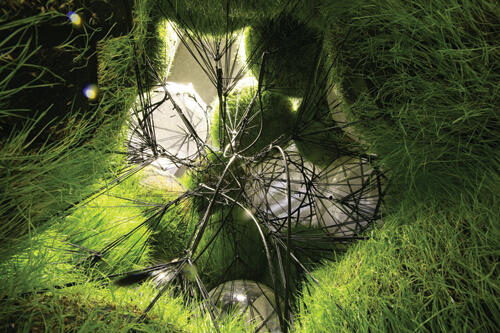 32SW/Stay green/Flying Garden/Air-Port-City, 2007/2009. Dimensions: Ø 193 in. Pillows with pressurized air, webbing, covered with black felt, grass, solar flexible panels, electrical cables, battery, solar pump, water supplying system, pool. Commissioned by Lyon Biennale 2007.
32SW/Stay green/Flying Garden/Air-Port-City, 2007/2009. Dimensions: Ø 193 in. Pillows with pressurized air, webbing, covered with black felt, grass, solar flexible panels, electrical cables, battery, solar pump, water supplying system, pool. Commissioned by Lyon Biennale 2007.
32SW/Siempreverde/Jardín volante/Ciudad aeropuerto, 2007/2009. Dimensiones: Ø 490 cm. Almohadas infladas con aire comprimido, red, cobertura de felpa negra, pasto, paneles solares flexibles, cables de electricidad, batería, bomba de agua por energía solar, pileta. Obra comisionada por la
Bienal de Lyon 2007.
Courtesy / cortesía: Tomás Saraceno; Tanya Bonakdar Gallery, New York; Andersen’s Contemporary, Copenhagen; Pinksummer, Genoa. -
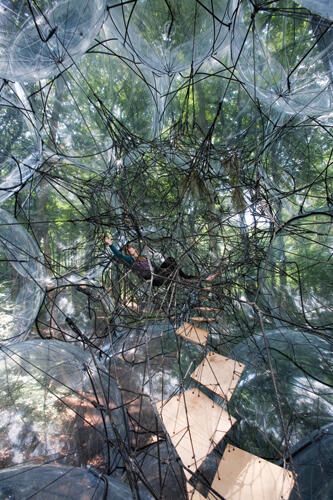 Flying Greenhouse, 2008. Air pillows, rope, Tillandsia plants, Ø 37.5 ft. Exhibited: Sonsbeek 2008: Grandeur, Sonsbeek, Arnhem, Netherlands Commissioned by Sonsbeek 2008.
Flying Greenhouse, 2008. Air pillows, rope, Tillandsia plants, Ø 37.5 ft. Exhibited: Sonsbeek 2008: Grandeur, Sonsbeek, Arnhem, Netherlands Commissioned by Sonsbeek 2008.
Invernadero volante, 2008. Almohadas inflables, cuerda, Tillandsias (claveles del aire), Ø11,4 m. Exhibida: Sonsbeek 2008: Grandeur, Sonsbeek, Arnhem, Países Bajos.
Courtesy / cortesía: Tomás Saraceno; Tanya Bonakdar Gallery, New York; Andersen’s Contemporary, Copenhagen; Pinksummer, Genoa. -
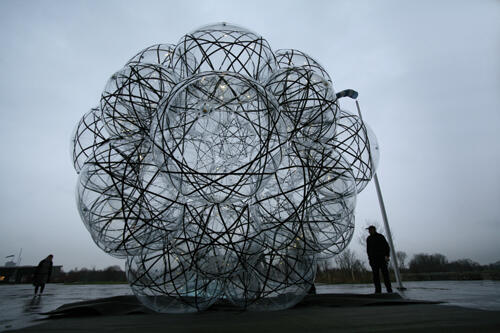 Biosphere MW32/Flying Garden/Air-Port-City (during installation), 2007. 12 elliptical pillows, 50.4 x 29.5 in., 20 elliptical pillows 67 x 39.4 in., webbing Ø177 in., installation variable.
Biosphere MW32/Flying Garden/Air-Port-City (during installation), 2007. 12 elliptical pillows, 50.4 x 29.5 in., 20 elliptical pillows 67 x 39.4 in., webbing Ø177 in., installation variable.
Biosfera MW32/Jardín volante/Ciudad aeropuerto (durante la instalación), 2007. 12 almohadas inflables elípticas 128 x 75 cm, 20 almohadas inflables elípticas 170 x 100 cm, red, Ø 450 cm, instalación de dimensiones variables.
Courtesy / Cortesía: Tomás Saraceno, Tanya Bonakdar Gallery, New York, Andersen’s Contemporary, Copenhagen, Pinksummer Contemporary Art, Genoa. -
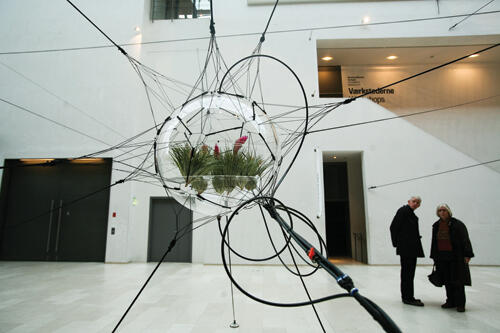 “Biosphere” (installation view), 2009 (in the framework of the cycle “RETHINK Relations”). Acrylic, inflatable modules, bowls filled with water and tillandsia plants, moss, elastic cords, carbon fiber, water dripping system, pump system. Exhibited: Statens Museum for Kunst, Copenhagen, Denmark, 2009.
“Biosphere” (installation view), 2009 (in the framework of the cycle “RETHINK Relations”). Acrylic, inflatable modules, bowls filled with water and tillandsia plants, moss, elastic cords, carbon fiber, water dripping system, pump system. Exhibited: Statens Museum for Kunst, Copenhagen, Denmark, 2009.
Biosfera (vista de la instalación), 2009 (en el marco del ciclo “REPENSAR las relaciones”). Acrílico, módulos inflables, recipientes con agua y Tillandsias (claveles del aire), musgo, cuerdas elásticas, fibra de carbono, sistema de riego por goteo, sistema de bombeo. Exhibida en el Museo Nacional de Arte,
Copenhague, Dinamarca, 2009.
Courtesy / Cortesía: Tomás Saraceno, Tanya Bonakdar Gallery, New York; Andersen’s Contemporary, Copenhagen; Pinksummer, Genoa.
-
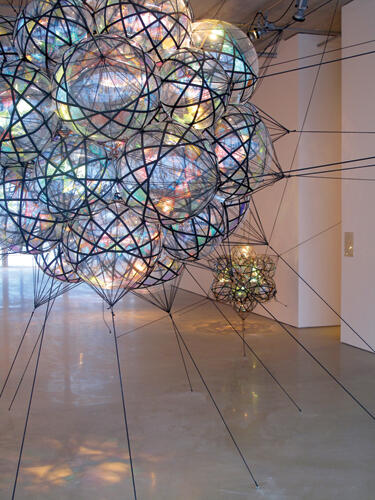 32SW iridescent/Flying Garden/Air-Port-City, 2007. Materials: 32 elliptical pillows, Ø 24 in., webbing, air, pump.
32SW iridescent/Flying Garden/Air-Port-City, 2007. Materials: 32 elliptical pillows, Ø 24 in., webbing, air, pump.
32SW iridiscente/Jardín volante/Ciudad aeropuerto, 2007. Materiales: 32 almohadas elípticas, Ø 61cm, red, aire, bomba.
Courtesy / cortesía: Tomás Saraceno; Tanya Bonakdar Gallery, New York; Andersen’s Contemporary, Copenhagen; Pinksummer, Genoa.
-
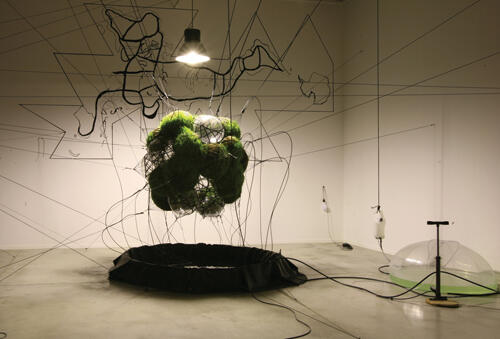 32SW/Stay green/Flying Garden/Air-Port-City, 2007/2009. Dimensions: Ø 193 in. Materials: pillows with pressurized air, webbing, covered with black felt, grass, solar flexible panels, electrical cables, battery, solar pump, water supplying system, pool. Commissioned by Lyon Biennale 2007.
32SW/Stay green/Flying Garden/Air-Port-City, 2007/2009. Dimensions: Ø 193 in. Materials: pillows with pressurized air, webbing, covered with black felt, grass, solar flexible panels, electrical cables, battery, solar pump, water supplying system, pool. Commissioned by Lyon Biennale 2007.
32SW/Siempreverde/Jardín volante/Ciudad aeropuerto, 2007/2009. Dimensiones: Ø 490 cm. Materiales: almohadas infladas con aire comprimido, red, cobertura de felpa negra, pasto, paneles solares flexibles, cables de electricidad, batería, bomba de agua por energía solar, sistema de provisión de agua, pileta. Obra comisionada por la Bienal de Lyon 2007.
Courtesy / cortesía: Tomás Saraceno; Tanya Bonakdar Gallery, New York; Andersen’s
Contemporary, Copenhagen; Pinksummer, Genoa.
-
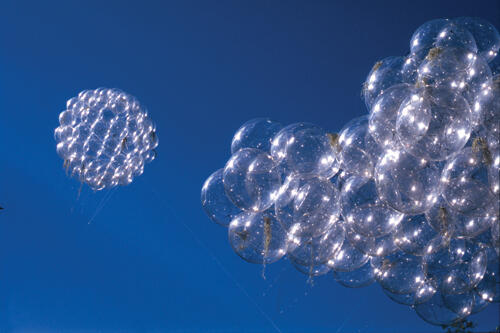 Flying Garden, Installation view, Villa Manin, 2005. Center for Contemporary Art, Codroipo, Italy. Photo © Sillani.
Flying Garden, Installation view, Villa Manin, 2005. Center for Contemporary Art, Codroipo, Italy. Photo © Sillani.
Jardín volante. Vista de la instalación, Villa Manin. 2005. Centro de Arte Contemporáneo, Codroipo, Italia. Fotografía © Sillani. -
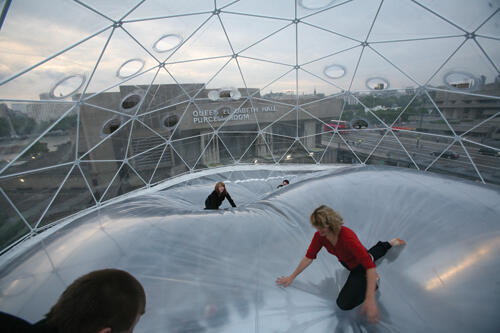 Observatory/Air-Port-City, 2008. Dimensions: Total height of the metal dome: 31.5 ft. Materials: lower room filled with pressurized air, metal dome, mirrored floor; entrance, exit and social behavior of the visitors. Clouds. Commissioned by Hayward Gallery, London.
Observatory/Air-Port-City, 2008. Dimensions: Total height of the metal dome: 31.5 ft. Materials: lower room filled with pressurized air, metal dome, mirrored floor; entrance, exit and social behavior of the visitors. Clouds. Commissioned by Hayward Gallery, London.
Observatorio/Ciudad aeropuerto, 2008. Dimensiones: Altura total del domo metálico: 9,60 m. Materiales: habitación nivel inferior rellena de aire comprimido, domo metálico, piso espejado; entrada, salida y conducta social de los visitantes. Nubes. Obra comisionada por la Galería Hayward, Londres.
Courtesy / cortesía: Tomás Saraceno; Tanya Bonakdar Gallery, New York; Andersen’s Contemporary, Copenhagen;
Pinksummer, Genoa.
-
 Working series (Salar de Uyuni – Bolivia) (working title), 2006. Series of 12 c-prints, 13 x 19.7 in. each, one out of a series of eight images.
Working series (Salar de Uyuni – Bolivia) (working title), 2006. Series of 12 c-prints, 13 x 19.7 in. each, one out of a series of eight images.
Serie en progreso (Salar de Uyuni – Bolivia) (Título provisional), 2006. Serie de 12 fotografías color, 33 x 50 cm c/u, una de una serie de 8 imágenes.
Courtesy / cortesía: Tomás Saraceno; Tanya Bonakdar Gallery, New York; Andersen’s Contemporary, Copenhagen; Pinksummer, Genoa.




